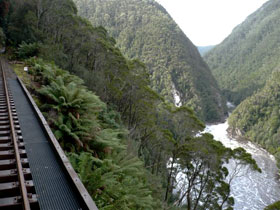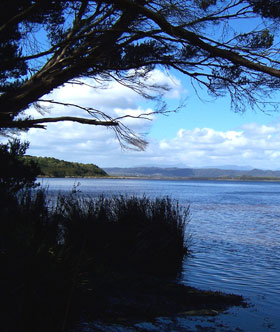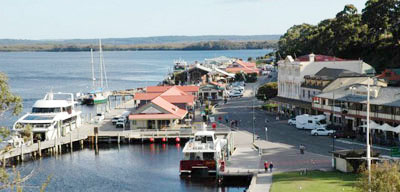 West Coast Wilderness Railway crossing the King River gorge on its way to Macquarie Harbour
West Coast Wilderness Railway crossing the King River gorge on its way to Macquarie Harbour

Swan Basin, Macquarie Harbour
![]()
Hogarth Falls
![]()
Strahan wharf
![]()
Ocean beach
![]()
ABT West Coast Wilderness Railway
|
Set on a quiet bay at the northern end of Macquarie Harbour, Strahan is a small, picturesque frontier-style town with an abundance of character and a variety of stories to tell of the West Coast's pioneering days. It is the only town on the west coast of Tasmania.

From its beginnings as the location for bushmen seeking precious Huon pine, Strahan became the railway port for a rich copper mine inland. Those days are long gone, and the only reminders of the copper boom days are an impressive post office and steamship offices.
What everyone come to Strahan to see these days is Macquarie Harbour, on whose shores the town stands, and the Gordon River, which flows through ancient Tasmanian rainforests, emptying its water - browned by the oils of the huon pine - into Macquarie Harbour south of Strahan. Unlike many other Tasmanian destinations, Strahan's landscapes, waves and weather are wild and elemental - typical of the south west Tasmanian World Heritage Wilderness in which it is located.
Where is it?: Tasmania: West Coast. Strahan is 44km from Queenstown and 298 km west of Hobart via Lyell Highway.
Things to see and do:
- Cruise Macquarie Harbour and Gordon River. More >>
- Ocean Beach is a huge expanse of sandy beach (40km long) and views of the Southern Ocean.
- Botanical Creek Park is preserved in its natural state
- At the northernmost end of Strahan Harbour is the Peoples Park, a pleasant mixture of natural forest and botanical gardens with picnic and camping facilities. Hogarth Falls is a 30 minute walk (each way).
- Ride the ABT West Coast Wilderness Railway. It runs daily between Strahan and Queenstown
- Bonnet Island Experience offers the rare opportunity to go ashore on a tiny island at the mouth of Macquarie Harbour.
Lookouts: Water Tower Hill offers an excellent view over Macquarie Harbour and shows how small Strahan really is.
Surrounding area:
Hells Gate, the entrance to Macquarie Harbour, was named by the convicts who were interned on Sarah Island. It neatly captures the dangers of the narrow entrance as well as the idea that this was beyond civilisation.
Cape Sorell Lighthouse: With the development of the silver and zinc mining fields at Zeehan in the 1890s, Strahan and Macquarie Harbour became a major west coast port. Cape Sorell Lighthouse was built in 1899 to guide ships into Macquarie Harbour.
Settlement (Sarah) Island: A convict station was established on Sarah Island in January 1822. It was a real hell hole (hence the name Hell's Gates for the entrance to the harbour) and had the harshest conditions of any penal establishment in the British Empire. By 1834 the settlement had been abandoned and a new penal settlement had been established at Port Arthur. Today only the remnants of the buildings are left.
Queenstown (44km east), the largest settlement on the west coast, was the centre for copper mining in the state's west coast region for over half a century. More >>
About Macquarie Harbour
Macquarie Harbour is the second-largest natural harbour in Australia after Port Phillip Bay in Victoria; it is six times the size of Sydney Harbour. However, the real glory of Macquarie Harbour and the town of Strahan on its shores is not the harbour's size but its setting; the surrounding wilderness and the Gordon River that flows through it are other-worldly, and in recent years have attracted local and international visitors to what is one of the last easily-accessible pristine wilderness areas left in the world.

Strahan history: The first recorded entry by a European into the landlocked Macquarie Harbour was made in 1815 by explorer James Kelly after whom Kelly Bay was named. in 1821 Governor Sorell decided to establish a penal settlement on the west coast of Tasmania and dispatched two ships with 74 convicts later the same year. Sarah Island, which had been named by Kelly (late it became Sattlement Island) was chgosen as the prison site. The settlement, however, lasted barely a decade. It was too difficult to supply. In 1834 it was abandoned and the convicts transferred to Port Arthur. In January the brig Frederick sailed out of the harbour with the last load of convicts. The convicts seized the ship and sailed her to South America, but were late retaken and condemned to death.
Macquarie Harbour was deserted for more than 40 years until the prospector Conrad Lynch found gold on King River. Timber getters also moved in and the village of Strahan was established. It became a loading point for ships carrying Huon pine logged in the Gordon River forests.
The copper boom at the Mt Lyell mine greatly accellerated Strahan's development. When the Strahan-Zeehan railway was opened in 1892, the village became a busy port. Seven years later in 1899, the Mt Lyell rack railway forged the link between the port and the mine. In two years, 1900 and 1901, the value of cargo which passed through Strahan exceeded that handled by any other Australian port.
By the early 1960s, road access to Queenstown had improved and the West Coast harsh conditions were taking their toll on the railway's trestle bridges. The last train ran on the original railway in 1963. It carried a shield with the proud motto of the Mt Lyell Mining and Railway Company – ‘Work conquers all – we find a way, or make it’.
|